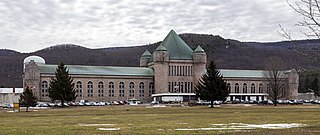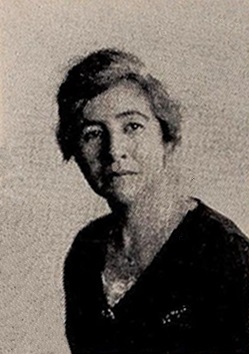Related Research Articles

Jacob Levy Moreno was a Romanian-American psychiatrist, psychosociologist, and educator, the founder of psychodrama, and the foremost pioneer of group psychotherapy. During his lifetime, he was recognized as one of the leading social scientists.
A reformatory or reformatory school is a youth detention center or an adult correctional facility popular during the late 19th and early 20th centuries in Western countries. In the United Kingdom and United States, they came out of social concerns about cities, poverty, immigration, and gender following industrialization, as well as from a shift in penology to reforming instead of punishing the criminal. They were traditionally single-sex institutions that relied on education, vocational training, and removal from the city. Although their use declined throughout the 20th century, their impact can be seen in practices like the United States' continued implementation of parole and the indeterminate sentence.

The Eastern Correctional Facility is a state prison for men in Napanoch, Ulster County, New York. Eastern is one of the oldest prison facilities in the state. It has been a maximum security prison for men since 1973.

Zebulon Reed Brockway was a penologist and is sometimes regarded as the "Father of prison reform" and "Father of American parole" in the United States.
Coxsackie Correctional Facility is a maximum security state prison in Coxsackie, Greene County, New York. It currently houses approximately 900 inmates. It is classified as a maximum security general confinement facility and detention center for men.
Dunsbach Ferry is a hamlet of the town of Colonie, in Albany County, New York, United States. The hamlet sits to the east of, and below, the Thaddeus Kosciusko Bridge, where Interstate 87 (I-87) crosses the Mohawk River. There are numerous private and public docks and landings between the Twin Bridges and the Colonie Town Park. Dunsbach Ferry was once an important river crossing and a stop on the Schenectady and Troy Railroad (T&S), later a branch of the New York Central Railroad. The ZIP code is 12047 (Cohoes).

Miriam Van Waters was an American prison reformer of the early to mid-20th century whose methods owed much to her upbringing as an Episcopalian involved in the Social Gospel movement. During her career as a penologist, which spanned most of the years from 1914 through 1957, she served as superintendent of three prisons: Frazier Detention Home for boys and girls in Portland, Oregon; Los Angeles County Juvenile Hall for girls, and the Massachusetts Correctional Institution – Framingham, then called the Massachusetts Reformatory for Women. While in California, Van Waters established an experimental reformatory school, El Retiro, for girls age 14 to 19. In each case, Van Waters developed programs that favored education, work, recreation, and a sense of community over unalloyed incarceration and punishment.
A protectory was a Roman Catholic institution for the shelter and training of the young, designed to afford neglected or abandoned children shelter, food, raiment and the rudiments of an education in religion, morals, science and manual training or industrial pursuits.
Fort Nassau was the first Dutch settlement in North America, located beside the "North River" within present-day Albany, New York, in the United States. The factorij was a small fortification which served as a trading post and warehouse.

The Ohio Reformatory for Women (ORW) is a state prison for women owned and operated by the Ohio Department of Rehabilitation and Correction in Marysville, Ohio. It opened in September 1916, when 34 female inmates were transferred from the Ohio Penitentiary in Columbus. ORW is a multi-security, state facility. As of July 2019, 2,394 female inmates were living at the prison ranging from minimum-security inmates all the way up to one inmate on death row. It was the fifth prison in the United States, in modern times, to open a nursery for imprisoned mothers and their babies located within the institution. The Achieving Baby Care Success (ABC) program was the first in the state to keep infants with their mothers.

Amy Ella Blanchard was a prolific American writer of children's literature.

The Minnesota Home School for Girls was a reformatory in Sauk Centre, Minnesota, United States. It was Minnesota's first single-sex reformatory for girls from its establishment in 1911 to 1967, when it switched to a coeducational model and shortened its name to the Minnesota Home School. The facility closed in 1999. The campus was designed on the Cottage Plan, with dispersed buildings in a bucolic setting, by Minnesota state architect Clarence H. Johnston Sr. The site has been converted to a veteran care center called Eagle's Healing Nest.
Kenwood was a hamlet in the Town of Bethlehem, New York. The hamlet spanned both sides of the Normans Kill near the area where the Normans Kill flows into the Hudson River. In 1870, and again in 1910, northern portions of Kenwood were annexed by the City of Albany, New York.

Frank Pierrepont Graves was Commissioner of the New York State Education Department from 1921 to 1940. Prior to assuming the commissionership, Graves was a noted historian of education, college administrator, and author.

The Western House of Refuge was a prison for children in Rochester, New York founded in the mid-1800's that was the first state managed reformatory in the United States. In the 1880's, the prison was changed into a vocational school known as the State Industrial School. In the early 1900's, the school would move to Industry, New York, where it now operates as the Industry Residential Center run by the state Office of Children and Family Services.
There are numerous nationally and locally designated historic sites and attractions in Westchester County. These include architecturally significant manors and estates, churches, cemeteries, farmhouses, African-American heritage sites, and underground railroad depots and waystations. There are sites from pre-Revolutionary and Revolutionary times, as well as battlegrounds. Westchester County also played an important role in the development of the modern suburb, and there are many associated heritage sites and museums.
The Children's Village, formerly the New York Juvenile Asylum, is a private, non-profit residential treatment facility and school for troubled children. It was founded in 1851 by 24 citizens of New York who were concerned about growing numbers of street children in New York. The necessity for such an institution was first proposed by the Association for Improving the Condition of the Poor, which helped to get it started.
The Magill Youth Training Centre, also known as the Boys Reformatory, McNally Training Centre and South Australian Youth Training Centre (SAYTC) since its founding in 1869, was the last iteration of a series of reformatories or youth detention centres in Woodforde, South Australia. The centre came under criticism in the 2000s for "barbaric" and "degrading" conditions and was replaced by a new 60-bed youth training centre at Cavan in 2012.
Keith (K.) Scott Christianson was an American author and journalist, who wrote several popular works about a variety of subjects, including American history and politics, forensic science, crime, prison and the death penalty, and about other popular subjects such as the history of incarceration, runaway slaves and historical highlights of visualization.

Jessie Donaldson Hodder was a women's prison reformer.
References
- ↑ Directive of New York state
- ↑ New York State Training School for Girls at Hudson, Albany : J.B. Lyon Co, 1904, p.3
- ↑ New York State Training School for Girls at Hudson, Albany : J.B. Lyon Co, 1904, p.5
- ↑ New York State Training School for Girls at Hudson, Albany : J.B. Lyon Co, 1904, p.11
- ↑ New York State Training School for Girls at Hudson, Albany : J.B. Lyon Co, 1904, p.11
- 1 2 3 Borgatti, Stephen P.; Mehra, Ajay; Brass, Daniel J.; Labianca, Giuseppe (2009). "Network Analysis in the Social Sciences". Science. 323 (5916): 892–895. Bibcode:2009Sci...323..892B. doi:10.1126/science.1165821. PMID 19213908. S2CID 522293.
- ↑ "The "Ungovernable" Ella Fitzgerald". 29 October 2014.
- ↑ Prison Public Memory blog, photo of log book with the name and arrival time of Ella Fitzgerald
- ↑ Center for Creative Photography
- ↑ Palfi, Marion. Suffer Little Children. New York: Oceana Publications.1952